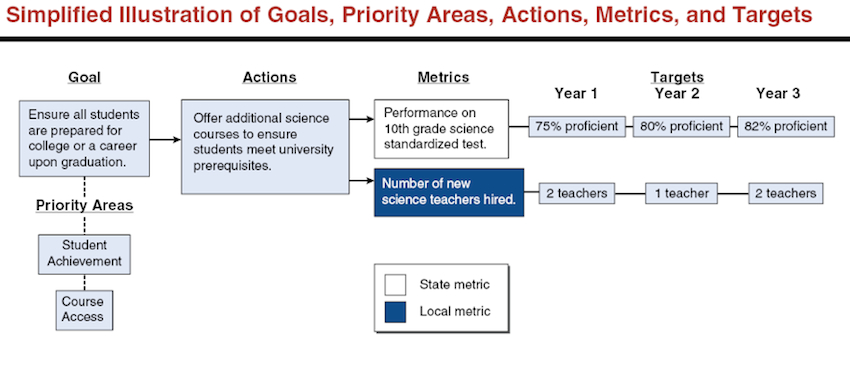Source: Legislative Analyst's Office The LAO cites an example of how a district might approach one goal – ensuring students are prepared for college or a career – with actions and metrics over three years.
Report says LCAPs need tighter focusBy John Fensterwald | http://bit.ly/1woPu1Z
January 20, 2015 :: Calling the new state-mandated local accountability plans “a daunting undertaking,” the Legislative Analyst’s Office called on the Legislature to allow school districts to write more focused annual plans for achievement. The plans, called the Local Control and Accountability Plans, or LCAPS, will become more meaningful if districts can concentrate on “their highest-priority areas” rather than give equal attention to the eight priority areas that the Legislature wrote into law, the LAO said in a report released Monday. The nonpartisan, independent agency studied 50 LCAPs, including those of the 11 biggest districts. The others represent a cross-section of the state’s 1,000 school districts. The LAO is urging lawmakers to require that districts be clearer in detailing how they will spend money to meet academic and other targets, especially additional funding mandated for “high-needs” students, including English learners and low-income students. The nonprofit advocacy group Education Trust-West made a similar recommendation in its study of districts’ LCAPs, issued last month. Children’s advocacy groups, such as Children Now and Public Advocates, are also recommending that approach.
Last year districts took their initial stab at the LCAP, a three-year planning document, updated annually, that’s required under the Local Control Funding Formula, the state’s new school financing system. The LCAP regulations require districts to set goals for improvement and describe actions they’ll take and money they’ll spend to achieve them in eight priority areas. Those areas include the rollout of the new state academic standards, parent involvement, school climate and academic achievement, which includes test scores, passage rates on Advanced Placement exams and the rate of redesignating English learners as proficient in English. County offices of education review districts’ LCAPs to verify that districts meet legal requirements and allocate enough money to pay for the districts’ commitments.
Districts followed temporary regulations last year. They faced a six-month deadline to reach out to parents and the community for their suggestions to complete their LCAPs by July 1. After months of hearing suggestions and complaints about the LCAP process, the State Board of Education strengthened the requirements for parental and student participation and updated the template for filling out the LCAP. The LAO acknowledged that the new template should help create a cleaner, more comprehensible document. But it won’t make the LCAP any less complex; only the Legislature can revise the basic requirements. Districts are required to address two dozen metrics and set goals for a dozen subgroups of students. They include not only English learners, low-income students and foster children, who get extra money under the new funding law, but also eight ethnic and racial groups and special education students. None of the districts met every statutory requirement, the report said. The LAO said that such ambitious requirements can lead districts to pay more attention to metrics and details than to larger strategies for improvement. The Legislature should let districts choose their highest priorities, the report said, as well as address critical areas needing improvement. The State Board of Education is developing a set of “evaluation rubrics” that will guide districts and county offices of education in identifying deficient areas in an LCAP; they may include statewide levels of achievement that schools and districts must meet over time. The board’s deadline for adopting the evaluation rubrics is Oct. 1. Other LAO recommendations for the Legislature include:
The LAO urges lawmakers to require LCAPs to cite all sources of funding that are going to English learners and low-income children, not just supplemental dollars under the funding formula. If, after a year of monitoring LCAPs, there is no improvement in the information provided, then the Legislature “could consider giving COEs (county offices of education) more authority to disapprove LCAPs that lack such detail.” Reached for comment Tuesday, Brooks Allen, deputy policy director and assistant legal counsel for the state board, wrote, “We’ve only reviewed the report briefly so far, but remain very open to all suggestions for how to improve student outcomes through the (Local Control Funding Formula) and LCAPs. We appreciate that the LAO highlights the improved LCAP and Annual Update template that (districts) will use for the first time this year and are interested to see the results of the first full year of LCAP implementation.” LAO education analysts Carolyn Chu and Edgar Cabral wrote the report. | Review finds first batch of LCAP’s lackingby Tom Chorneau + SI&A Cabinet Report | http://bit.ly/15tHYgoJanuary 21, 2015 (Calif.) :: The first comprehensive review of how school districts are meeting new reporting requirements tied to state aid for disadvantaged students found none that had complied with every statutory mandate. As part of the restructuring of state support for schools adopted two years ago, local educational agencies have been required to develop plans that show how they will use the funds to improve services to low-income students, English learners and foster youth. In a report released Tuesday, the non-partisan Legislative Analysts Office evaluated 50 Local Control Accountability Plans adopted last summer – the first year of the filing – in a pool that represented districts small-to-large, all of the geographic regions as well as the state’s 11 biggest LEAs. The LCAP process, which many districts struggled to complete, called for a wide range of new activities and reporting demands. The Legislature set eight educational priorities and called on districts to set goals based on the priorities, describe actions they would take to reach the goals and track their progress. As part of the LCAP format, the state also outlined 24 performance metrics that fit within the priorities. The measures were required across 12 student subgroups. Districts were also required for the first time to formally engage parents and community groups in the process of building the school budget and the LCAP. “Fulfilling all of these requirements is a challenging undertaking for districts to accomplish and accomplish well,” the LAO said in its report. “Though most of the LCAPs we reviewed attempted to comply with many of the statutory LCAP requirements, none complied with every statutory requirement.” Another significant and common failing, the LAO said, was that most LCAPs did not distinguish between actions that had been ongoing and those initiatives just undertaken. Without some better description, “we could not determine whether districts were using the new funding generated under LCFF to pursue new actions to improve performance or to continue or expand prior activities,” the research team said. The report also raised concerns that administrators were funding programs that benefitted all students at a certain school and not necessarily low-income, English learners and foster youth. Often, the LAO said, the LCAP indicated that actions taken on behalf of all students would also benefit the educationally disadvantaged. The LAO said lawmakers should consider making some changes to the program:
The LAO said the state should monitor LCAP descriptions over the next few years for indications that services match expectations. As part of that process, they suggested the Legislature hold an informational hearing in the fall of 2016 – after another round of funding and reporting – to get feedback from schools and other stakeholders. |



No comments:
Post a Comment